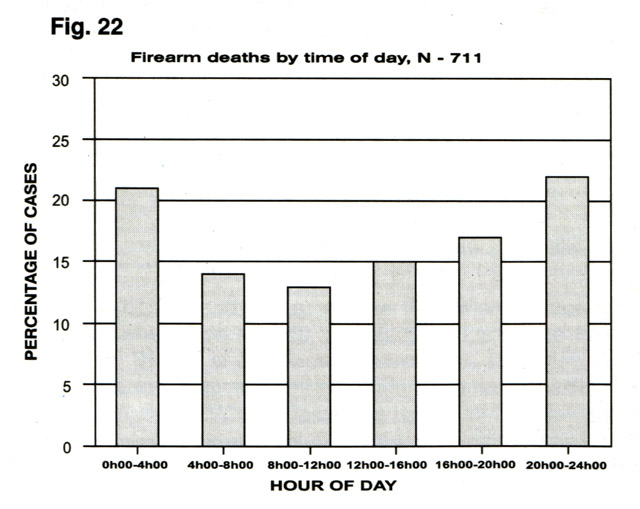 |
Most incidences occur between 20h00 and 04h00, accounting for 45% of cases. Most firearm deaths occur over the weekends. Qualitative data suggests that alcohol is involved in the majority of these cases.
 |
Non-Fatal Firearm Injuries
In the United States, for every firearm-related death, there are approximately 3 non-fatal incidents6, the majority of which require emergency medical care. This figure is not yet available for South Africa because non-fatal injury data is not routinely collected. In a Cape Town study of all patients who presented to the trauma unit at Groote Schuur Hospital in 19937 males outnumbered females by 8:1 and the average patient age was 28 years. Over 50% arrived on weekends, and on all weekdays most presented after 17h00 hours. Handguns were involved in 40% of injuries. Most victims had only one bullet wound, but just over 6% had multiple bullet or shotgun pellet wounds.
Existing information clearly shows that firearm injuries are frequent, severe, and costly but the economic cost of firearm injuries to society is enormous1.
Of all trauma cases, the fast rising number of firearm-related injuries are the biggest expense. Firearm-related injuries are more costly than most other types of injury for at least two reasons, discussed below. Firstly, firearm-related injuries tend to be more severe than other types of injury and are therefore more difficult and expensive to treat. Gunshot injuries often result in multiple injuries, requiring admission to ICU and more than one operation. At King Edward VIII Hospital, the average stay in ICU is 7 days, with an average cost of R5000 per day3.
In the Cape Town study mentioned above7, the 969 patients with firearm injuries cost the hospital R3 858 331 to treat (including visits to outpatient
59